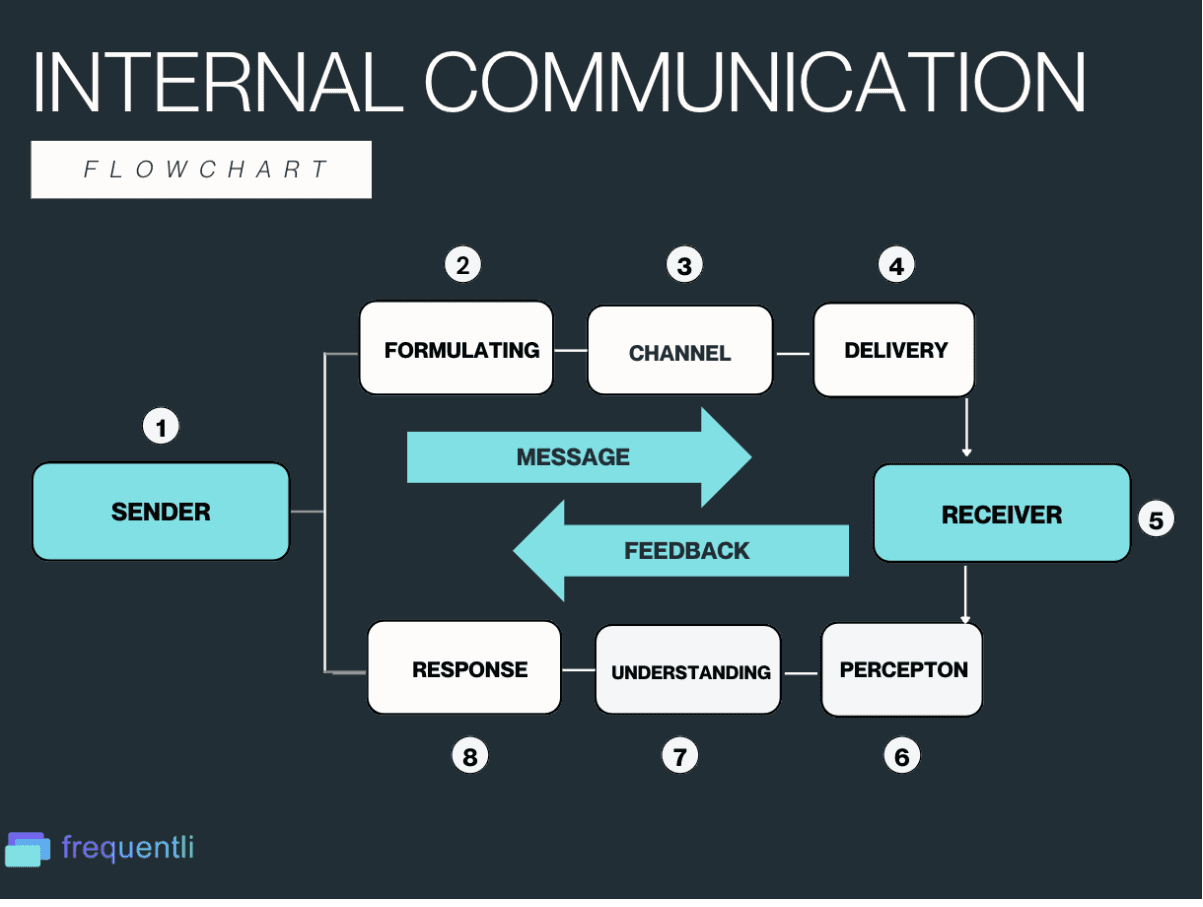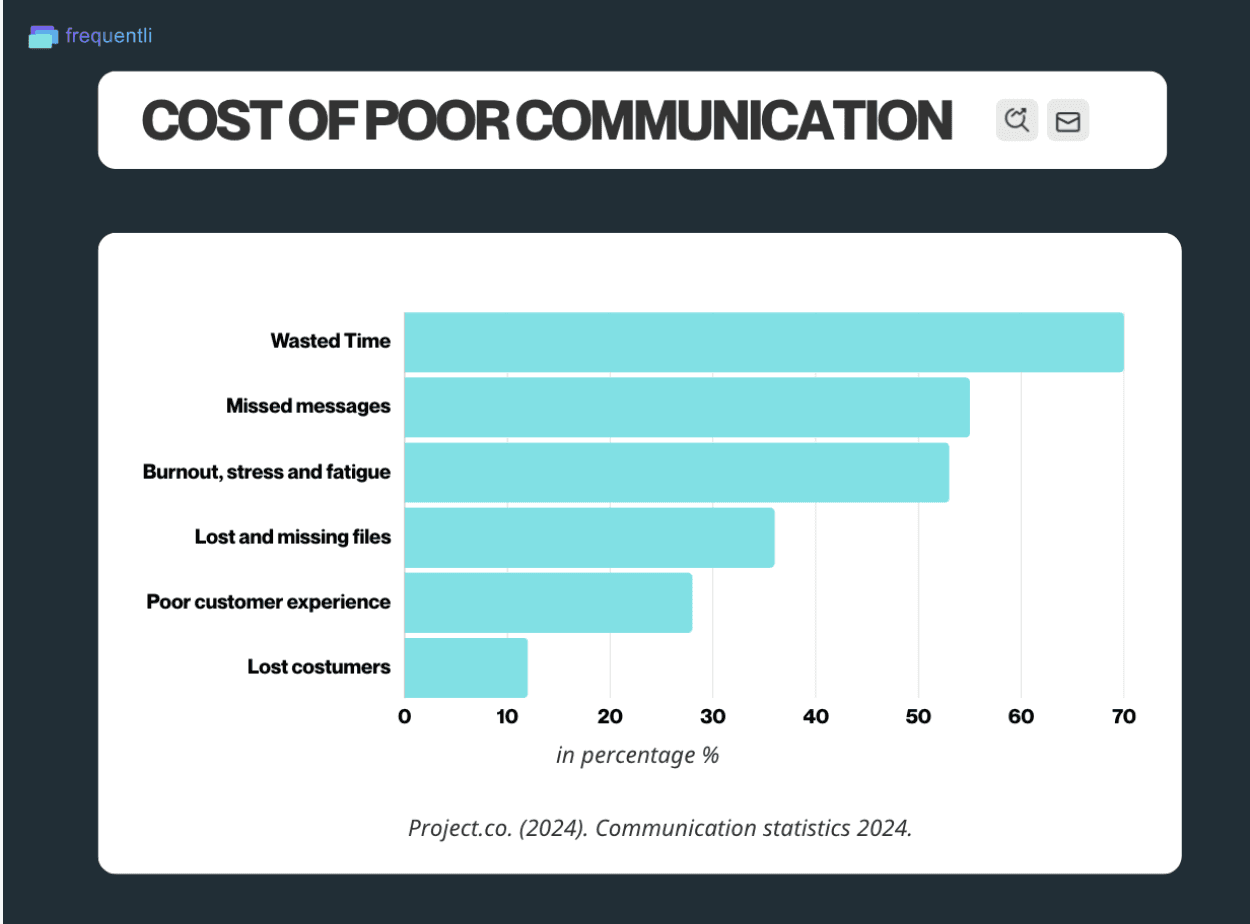
Internal Communication: What It Is and Why It’s Important For Businesses
There’s one key factor that sets thriving companies apart from the rest—effective internal communication.
More than just sharing updates or sending emails, internal communication is the lifeblood of any successful organization. It ensures that communication flows smoothly across teams, leaders, and departments. The importance of internal communication in modern businesses cannot be overstated. When employees feel informed, connected, and valued, they are more likely to perform at their best.
So if you find yourself in an organization that is currently struggling with internal communication, this blog will help you understand what it is and why it matters.
What is Internal Communication?
At its core, internal communication refers to the process of sharing information, ideas, and updates within an organization.
In our previous blog, we talked about the 3 Ways to Level Up Your Teamwork and Team Communication where we learned the effective ways to enhance internal communication between teams.
Internal communication is where your team stays connected, informed, and aligned on business goals and daily operations. Whether it's a quick email, an all-hands meeting, or chatting on a collaboration tool like Prompteam.ai, internal communication plays a pivotal role in the smooth running of any business.

Internal Communication Flowchart adapted from SlideTeam. (n.d.). Communication flow steps organization department
This internal communication flowchart illustrates sending, receiving, and responding to messages within a business team. It starts with the Sender formulating a message, which is then delivered through a specific Channel (e.g., email, meetings).
The Receiver interprets the message based on their Perception and Understanding, ensuring clarity before providing a Response or taking action. The crucial Feedback loop allows the sender to receive updates or further communication from the receiver, ensuring two-way communication.
Examples of Internal Communication Methods
Internal communication comes in many forms, and in today’s digital age, businesses have an array of tools to keep their teams connected. Some of the most common methods include:
Emails: Still a go-to for formal communication, company-wide updates, or sharing detailed information.
Meetings: Whether in-person or virtual, meetings are essential for team discussions, project updates, and strategic planning.
Collaboration Tools: Platforms like Prompteam.ai, Slack, Microsoft Teams, and Asana make real-time communication and task management easier, especially for remote and hybrid teams.
Internal Newsletters: A great way to inform employees about company achievements, upcoming events, or significant changes.
Video Conferencing: Tools like Zoom and Google Meet allow teams to stay connected, especially when remote work is standard.
According to a 2020 study by McKinsey, businesses with solid internal communication practices are 25% more productive than those without. These companies also experience higher employee engagement, with 74% of employees feeling more valued when there’s consistent communication from leadership.
Internal vs. External Communication
While internal communication focuses on the exchange of information within the company, external communication is about how a business interacts with individuals or entities outside the organization—like clients, investors, or the media.
Here’s a quick breakdown:
Internal Communication: Between team members, departments, and organizational management.
External Communication: With customers, partners, vendors, and the public.
Both are essential, but internal communication lays the groundwork for your team to operate efficiently. It is the glue that holds your company together, while external communication helps build relationships with the outside world.
With effective internal communication, even the best external strategies can stay intact due to misalignment within the team.
Key Components of Effective Internal Communication
When building internal solid communication within your business, it’s essential to focus on four key components: transparency, clarity, two-way communication, and consistency. These pillars help create an open, connected, and engaged workforce, which in turn, drives better business outcomes.
1. Transparency
Transparency is about being open and honest with your team. This means sharing successes, challenges, and areas where the business needs to improve. When leaders practice transparency, it fosters trust and loyalty within the workforce. This is especially true in task management between virtual teams. Open-door policies, transparent leadership decisions, and regular updates on company performance are simple ways to promote transparency.
2. Clarity
In internal communication, clarity is also very important. Unclear or ambiguous messages can lead to confusion, mistakes, and misalignment across departments. According to McKinsey, employees spend an average of 2.5 hours per day searching for the information they need to do their jobs, costing companies billions annually in lost productivity.
To avoid this, make sure your messaging is concise, straightforward, and free of jargon.
3. Two-Way Communication
Effective communication isn’t just about sending messages; it’s about creating a two-way dialogue. Employees want to feel heard, and companies that encourage feedback benefit from better engagement. In fact, companies that promote regular feedback see 14.9% lower turnover rates compared to those that don’t, according to Gallup.
Encourage open channels for feedback, whether through employee surveys, suggestion boxes, or regular one-on-one meetings. More importantly, act on the feedback to show employees that their voices matter. This kind of open communication boosts morale and fosters a sense of ownership among team members.
4. Consistency
Lastly, consistency in communication helps maintain clarity and alignment across teams. Irregular or sporadic updates can lead to confusion, especially in larger organizations. A study by Harvard Business Review found that 70% of employees feel more engaged when their managers provide consistent, meaningful communication.
Regular communication keeps everyone on the same page and ensures that no one feels left in the dark. Whether it’s weekly updates, monthly town halls, or quarterly reports, consistency builds trust and reduces the likelihood of misunderstandings.
Why Your Business Needs Effective Internal Communication
We have previously established how Internal communication is more than just sending emails and holding meetings—it's the backbone of a successful organization. Not to mention the cost it can incur to businesses.
This data from Project.co stresses underscores the financial and operational consequences of inadequate internal communication in the workplace. It has led to waste of time due to communication issues, burnout and fatigue, missing important notifications at work and many other costly effects.

Statistics showing the cost of poor communication in businesses
That’s why having strong internal communication in your workplace is crucial to your business’s success. In addition to that, here are several more reasons why prioritizing internal communication can greatly benefit your organization.
It Enhances Employee Engagement and Satisfaction
When employees feel informed and heard, their job satisfaction skyrockets, and clear communication shows employees that they are valued and included in the company’s success.
According to a study by TINYpulse, 87% of employees who feel connected to the business’s goals through transparent communication are likelier to remain loyal to the company.
Meanwhile, Gallup’s State of the Global Workplace: 2023 Report showed that disengaged employees result in a staggering $8.8 trillion in lost productivity worldwide.
Furthermore, effective communication can reduce turnover, with engaged employees being 87% less likely to leave their organization.
Employees who are kept in the loop about company goals and performance feel more connected to the organization.
Boosts Productivity and Efficiency
Effective internal communication streamlines marketing processes and reduces misunderstandings, helping employees stay aligned with their tasks and deadlines. Poor communication can lead to bottlenecks and delays, costing businesses valuable time.
When teams understand their roles and expectations clearly, they can focus on what matters most. This eliminates the need for constant clarifications and unnecessary meetings, freeing time to efficiently meet business goals.
Encourages Collaboration and Innovation
Open communication encourages employees to share ideas, collaborate, and work toward common goals. A collaborative culture fosters innovation and creative problem-solving. Recently, the State of Business Communication in 2023, conducted by the Harris Poll for Grammarly, reveals that 72% of business leaders feel that effective communication has boosted their team's productivity, while 52% of knowledge workers agree.
Encouraging feedback and open dialogue helps break down silos, making it easier for teams to work cross-functionally and come up with innovative solutions.
Improves Company Culture
Internal communication is also crucial in shaping a positive and inclusive company culture. Transparent communication builds trust between leadership and employees, fostering a sense of belonging. Companies that prioritize their employees' performance are 4.2 times more likely to surpass their competitors, achieving an average revenue growth of 30%.
A culture of openness also makes employees feel comfortable raising concerns or suggesting improvements, leading to a more positive work environment and stronger team relationships.
Enables Better Decision-Making
Effective internal communication ensures that employees and leaders are well-informed and able to make better, data-driven decisions. When teams have access to accurate and timely information, they can respond quickly to challenges or changes in the business landscape.
Clear communication also helps leaders gather insights from their teams, leading to more inclusive and informed decision-making processes.
Check this out: Top 15 Generative AI Tools You Need in 2024
Google’s TGIF- Promoting Transparency and Engagement
Google has long prioritized open communication and employee engagement, which are key to its innovation and growth. One of the main initiatives fostering this culture is the TGIF (Thank God It’s Friday) meetings, introduced in 2002. These weekly sessions allowed employees to ask questions directly to leadership, fostering transparency and engagement, even as the company rapidly expanded.
Challenges & Implementation
As Google grew, maintaining its open culture became difficult. TGIF meetings helped bridge communication gaps, ensuring employees were connected to the company’s mission and leadership.
Over time, the meetings evolved to meet the company’s global needs, broadcasting them to offices worldwide and addressing diverse employee concerns.
Outcomes:
Short-term: Increased transparency, engagement, and faster problem-solving. Employees felt more involved, leading to higher morale.
Long-term: Sustained innovation, strong corporate culture, and a cohesive global workforce. The meetings played a critical role in maintaining the startup-like culture at scale.
Studies conducted within Google, such as Project Aristotle, revealed that communication and team dynamics, mainly psychological safety, were key drivers of success. Teams with solid communication channels, where members felt safe to voice ideas and take risks, consistently outperformed others, achieving a 17% increase in revenue in some cases.
This demonstrates how internal communication directly impacts team effectiveness and business outcomes.
Moreover, Google’s TGIF meetings fostered a sense of transparency and ownership, where employees felt more connected to the company’s mission. These initiatives helped Google maintain a strong corporate culture that promoted high employee engagement, reducing the risk of miscommunication and boosting productivity.
Conclusion
Strong internal communication is vital to running a successful business. It enhances transparency, keeps employees engaged, increases productivity, and encourages innovation. If internal communication isn’t already a priority in your organization, now is the perfect time to review how information flows and find ways to make it more effective.
As a next step, examine the communication tools you're using and ensure that feedback channels are open, clear, and consistent. In the next blog, we’ll explore strategies to overcome the Common Challenges in Internal Communication that many businesses face.
Stay tuned to ensure your internal communication practices are optimized for success! If your interested in learning how to automate processes in your organization, considering reading this guide on How to Unlock 100x Sales Success with an Automated Customer Service
